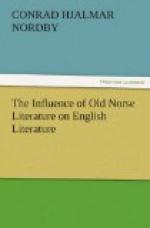Botilda.
Oh!
God grant,
You be not fey, nor truly
near your end!
(Act. IV, Sc. III.)
Although this work is dramatic in form, it is not so in spirit. The true dramatist would have put such an incident as the swearing of brotherhood into a scene, instead of into a speech. This effort is, however, the nearest approach to a drama in English founded on saga material. It is curious that our poets have inclined to every form but the drama in reproducing Old Norse literature. It is not that saga-stuff is not dramatic in possibilities. Ewald and Oehlenschlaeger have used this material to excellent effect in Danish dramas. Had the sagas been accessible to Englishmen in Shakespeare’s time, we should certainly have had dramas of Icelandic life.
IV.
BY THE HAND OF THE MASTER.
Time has brought us to the man whose work in this field needs no apology. The writer whom we consider next contributed almost as much material to the English treasury of Northern gold as did all the writers we have so far considered. Were it not for William Morris, the examination that we are making would not not be worth while. The name literature, in its narrow sense, belongs to only a few of the writings that we have examined up to this point, but what we are now to inspect deserves that title without the shadow of a doubt. For that reason we set in a separate chapter the examination of Morris’ Old Norse adaptations and creations.
WILLIAM MORRIS (1834-1896).
The biographer of William Morris fixes 1868 as the beginning of the poet’s Icelandic stories.[30] Eirikr Magnusson, an Icelander, was his guide, and the pupil made rapid progress. Dasent’s work had drawn Morris’ attention to the sagas, and within a few months most of the sagas had been read in the original. Although The Saga of Gunnlang Worm-tongue was published in the Fortnightly Review, for January, 1869, the Grettis Saga, of April, was the first published book on an Old Norse subject. The next year gave the Voelsunga Saga. In 1871, Morris made a journey through Iceland, the fruits of which were afterwards seen in many a noble work. In 1875, Three Northern Love Stories was published, and, in 1877, The Story of Sigurd the Volsung and the Fall of the Niblungs. More than ten years passed before he turned again to Icelandic work, the Romances of the years of 1889 to 1896 showing signs of it, and the translations in the Saga Library, “Howard the Halt,” “The Banded Men,” Eyrbyggja and Heimskringla of 1891-95. These contributions to the subject of our examination are no less valuable than voluminous, and we make no excuses for an extended consideration of them. They deserve a wider public than they have yet attained.




